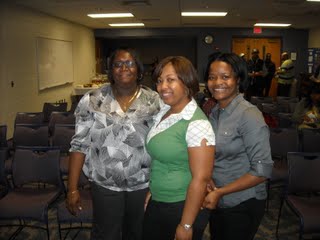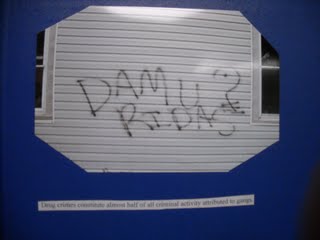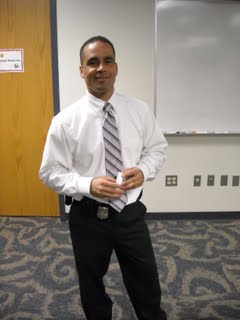2009-12-30
Gangs Update!

L.A. Gangs Seek Profit in Peace
Violence Ebbs as Criminal Alliances Emerge in New Test for Authorities
By TAMARA AUDI
LOS ANGELES -- After nearly two decades fighting gangs, Los Angeles County Sheriff's Detective Robert Lyons thought he had seen it all. Until he saw members of the Bloods and the Crips -- rival gangs that spent years in brutal conflict -- meeting amiably in a restaurant.
"They were talking. There was hugging and high-fiving. It was unbelievable," Mr. Lyons said. He has heard a refrain from gang members: Red (the Bloods) and blue (the Crips) make green (money).
 Left, members of the Bloods and the Crips, rival Los Angeles street gangs, during a truce attempted in 1992 after the acquittal of police officers in the beating of Rodney King. Below, Crips members in Los Angeles in 1988.
Left, members of the Bloods and the Crips, rival Los Angeles street gangs, during a truce attempted in 1992 after the acquittal of police officers in the beating of Rodney King. Below, Crips members in Los Angeles in 1988.Gangs that were once bloody rivals now are cooperating to wring profits from the sale of illegal drugs and weapons, law-enforcement officials and gang experts say. In some cases, gangs that investigators believed to be sworn enemies share neighborhoods and strike business deals. The collaboration even crosses racial lines, remarkable in a gang world where racial divisions are sharp and clashes are often racially motivated.
"You see African-Americans dealing with Hispanics on obtaining narcotics and weapons. We're seeing Hispanic gang members involved with the Eastern European criminal figures," said Robert W. Clark, acting special agent in charge of the criminal division of the Los Angeles field office of the Federal Bureau of Investigation. "Where they see opportunities to collaborate, they do."
Gang activity has been one of the most intractable crime problems facing Southern California for decades, terrorizing communities, claiming hundreds of lives a year in some periods and also breeding a nexus of criminal activity that has been exported to other communities. Los Angeles, along with Chicago, has long been considered one of the centers of gang activity in the U.S.
But gang-related violence is at a 30-year low in Los Angeles, according to experts. Gang-related homicides in Los Angeles totaled 128 in through October of this year, compared with 312 in all of 2002. All reported gang-related crimes, including rape, assault and robberies, totaled 4,899 through October, compared with 7,432 in 2002.
 The sharp drop is undoubtedly a landmark success for law-enforcement officials and policy makers, who have used aggressive policing and rehabilitation programs to tackle the problem. But the reports of alliances between formerly warring gangs potentially offers a different explanation: Gangs are committing less violence because they are partnering on criminal activity, creating new challenges for law enforcement.
The sharp drop is undoubtedly a landmark success for law-enforcement officials and policy makers, who have used aggressive policing and rehabilitation programs to tackle the problem. But the reports of alliances between formerly warring gangs potentially offers a different explanation: Gangs are committing less violence because they are partnering on criminal activity, creating new challenges for law enforcement."Now, instead of having 200 guys that are arch-enemies with 200 other guys, you have 400 guys working together against law enforcement," said the sheriff's detective, Mr. Lyons.
There are still plenty of rivalries and violence. One Los Angeles-area Latino gang, Barrio Hawaiian Gardens, was charged this spring with hate crimes against African-Americans -- including targeted shootings.
Tracking the number of gang members is notoriously tricky, and membership is fluid. But a November report from the California Gang Node Advisory Committee, which attempts to track gang membership, put the number of gang members at 85,832 in Los Angeles County, up slightly from recent years.
And the number of gang members has been on the upswing nationally. There were about one million gang members in the U.S. in 2008, up from 800,000 in 2005, according to the National Gang Threat Assessment, compiled by the National Gang Intelligence Center and the National Drug Intelligence Center.
Some regions of the country -- like New England, with 640 gangs -- are seeing an increase in violence as gangs grow and fight for control of neighborhoods and the drug trade, the report said. But there is cohesion in other regions, like Washington and Oregon, where "alliances between gangs may result in the expansion of criminal networks and increased criminal activity in the Northwest Region," the report says.
In Los Angeles, federal and local law-enforcement agencies have launched massive investigations and raids against gangs. In 2009, law-enforcement officials arrested more than 650 gang members in Southern California, according to the FBI.
City officials also credit gang-prevention and rehabilitation programs for the drop in crime. Gang intervention workers -- often former gang members -- work alongside police to prevent retaliatory shootings. Homeboy Industries, a privately funded gang-rehabilitation program in Los Angeles, serves around 12,000 people a year who have left gangs, providing job training, counseling and tattoo removal. And the mayor's office has sponsored activities like basketball games and picnics among neighborhoods that are home to feuding gangs.
But intensifying pressure from police has also prompted gangs to work together, said Jorja Leap, a University of California, Los Angeles professor and gang expert. "They really are united against what they perceive to be a common enemy -- law enforcement," said Ms. Leap, who now advises Los Angeles County Sheriff Leroy Baca on gangs.
Ms. Leap said gangs form links to survive -- and to maximize profits. "The market is tougher and they're consolidating," she said.
Los Angeles Police Chief Charlie Beck said gangs are "treating their activities more like businesses than before. In business, you work with whoever you have to."
 This collaboration can make tracking gang crime and dismantling gangs more complicated. Members of street gangs are showing up unexpectedly in health-care and credit-card fraud investigations, which have traditionally been run by Eastern European crime rings.
This collaboration can make tracking gang crime and dismantling gangs more complicated. Members of street gangs are showing up unexpectedly in health-care and credit-card fraud investigations, which have traditionally been run by Eastern European crime rings.During a two-year investigation of the Athens Park Bloods, an African-American gang entrenched in south Los Angeles, investigators learned the members had formed a pact with a Hispanic gang called Barrio 13. Eventually, 22 people were charged -- 20 African-Americans and two Hispanics.
"They shared the same guns, the same narcotics, the same neighborhood," said Mr. Lyons, the sheriff's detective.
Write to Tamara Audi at tammy.audi@wsj.com
Printed in The Wall Street Journal, page A3
Labels: crips, gangs, graffiti, graffiti removal, help, Latin Kings, NETA, new jersey, pictures, Police, voilence
2009-11-10
Monmouth U Students put on Anti-Gang Seminar in Vineland, NJ
Concerned Citizens this Monday got a gang of new information on Cumberland County gangs this Monday.
 Monmouth University Students held a Gang Violence Awareness Seminar at the Vineland City Library this Monday, November 9th. Spurred to action by Cumberland County’s rise in gang related crime in the last year, Grad Students Janice Powell, Coraline Evans, and Brenda Herbert, enlisted Detective Martinez to help give the community of Vineland the information they need to know about Gang Activity in the area.
Monmouth University Students held a Gang Violence Awareness Seminar at the Vineland City Library this Monday, November 9th. Spurred to action by Cumberland County’s rise in gang related crime in the last year, Grad Students Janice Powell, Coraline Evans, and Brenda Herbert, enlisted Detective Martinez to help give the community of Vineland the information they need to know about Gang Activity in the area.
Detective Martinez works with a 5 member gang unit within the Vineland Police Department. Martinez spoke about what gangs are, what gangs are in the area, the warning signs of gang activity, and most importantly of all, how to know if young friend or family member is getting involved with gang activity.
A Gang is defined as, “a group of 3 or more people who have a common name, sign, or identifying symbol, and who engage in criminal activity. Both males and females from all neighborhoods, races, cultures, religions and economic levels are affiliated with gangs. “
Bloods, Crips, the 18th Street Gang, and the 7th Street Gang/ Uptown Boys are the most prevalent gangs in the Cumberland County area.
Different gangs often communicate with each other via graffiti. Graffiti can be a mark of one gang’s territory, or it can be a call to war against other gangs. Graffiti helps keep police current on gang activity, but it also agitates relations between gangs, which can lead to violence and homicides. That’s why the Vineland Chief of Police is hard on graffiti, initiating a strict policy of, “report, record, remove.”
 According to Bio-Clean of New Jersey CEO Andrew Yurchuck, “Graffiti is a crime stimulant. A town laden with graffiti will see higher crime rates then a town that is graffiti free. We will dispatch a team immediately and get the property back to its original condition quickly and efficiently. We have recently invested thousands of dollars in state of the art graffiti removal equipment. Our professional staff is highly trained so the business owner can get back to their daily activities with the peace of mind that their building will look brand new once again. Insurance companies will pay for the graffiti removal.” (For more information on our graffiti removal services, check out our website, or call (856) 307-1051. )
According to Bio-Clean of New Jersey CEO Andrew Yurchuck, “Graffiti is a crime stimulant. A town laden with graffiti will see higher crime rates then a town that is graffiti free. We will dispatch a team immediately and get the property back to its original condition quickly and efficiently. We have recently invested thousands of dollars in state of the art graffiti removal equipment. Our professional staff is highly trained so the business owner can get back to their daily activities with the peace of mind that their building will look brand new once again. Insurance companies will pay for the graffiti removal.” (For more information on our graffiti removal services, check out our website, or call (856) 307-1051. )
Detective Martinez went on to stress the importance of all parents monitoring their children for potential gang activity. Modern gangs know no bounds of age, race, or gender. Many gangs prefer kids who wouldn’t be suspected of doing crime, and will make friends with socially outcasted nerdy kids only to use them to peddle drugs. Gangs look for “wannabes” who could be an, “asset,” to the gang. If the gang can exploit and use your child, they will try to. Kids join gangs because they seek a sense of belonging, power, self-worth, status, physical protection, income, excitement and companionship. No child is safe from gangs unless a parent takes preventative action.
Detective Martinez then gave some tips on how to find out if your child is in a gang.
 -If your child admits to “hanging out” with kids in gangs.
-If your child admits to “hanging out” with kids in gangs.
-If your child shows an unusual interest in one or two colors of clothing or a particular logo.
-If your child has an unusual interest in gangster-influenced music, videos, movies or websites.
-If your child uses unusual hand signals to communicate with friends
-If your child has specific drawings or gang symbols on school books, clothes, walls or tattoos.
-If your child comes home with unexplained physical injuries (fighting-related bruises, injuries to hands and/or knuckles.
-If your child has unexplained cash or goods, such as clothing or jewelry
-If your child carries a weapon
-If your child has been in trouble with the police.
-If your child exhibits changes in behavior such as:
-Withdrawing from family
-Declining school attendance
-Declining School performance, and or behavior
-Staying out late without reason
-Displaying an unusual desire for secrecy
-Exhibiting signs of drug use
-Breaking rules consistently
-Speaking in gang-style slang
Martinez stressed that parents should not be afraid to deeply investigate into their child’s life if they suspect gang activity. Parents should not be afraid to search their child’s room if gang membership is suspected. Kids may draw gang logos on the inside of their jackets and then flip them inside out when at school. Kids also keep gang colored handkerchiefs hidden in their back pockets underneath of large white T-shirts.
Parents should be concerned about the criminal activity that their child would be involved in if members of a gang, but even more concerning is the violence they would be exposed to. Gang members frequently carry weapons, and if two rival gangs meet up it could mean homicide. Furthermore, many gangs initiate their members with, “beat-ins,” an initiation process in which a new member is beaten by a gang of current members for 30 seconds.
The war on gangs continues, but hopefully, the City of Vineland is a little more educated about gangs, and a little more ready to battle gangs with preventative measures in the home.
Check back tomorrow for information about specific gangs in Cumberland County!
Detective Martinez works with a 5 member gang unit within the Vineland Police Department. Martinez spoke about what gangs are, what gangs are in the area, the warning signs of gang activity, and most importantly of all, how to know if young friend or family member is getting involved with gang activity.
A Gang is defined as, “a group of 3 or more people who have a common name, sign, or identifying symbol, and who engage in criminal activity. Both males and females from all neighborhoods, races, cultures, religions and economic levels are affiliated with gangs. “
Bloods, Crips, the 18th Street Gang, and the 7th Street Gang/ Uptown Boys are the most prevalent gangs in the Cumberland County area.
Different gangs often communicate with each other via graffiti. Graffiti can be a mark of one gang’s territory, or it can be a call to war against other gangs. Graffiti helps keep police current on gang activity, but it also agitates relations between gangs, which can lead to violence and homicides. That’s why the Vineland Chief of Police is hard on graffiti, initiating a strict policy of, “report, record, remove.”
Detective Martinez went on to stress the importance of all parents monitoring their children for potential gang activity. Modern gangs know no bounds of age, race, or gender. Many gangs prefer kids who wouldn’t be suspected of doing crime, and will make friends with socially outcasted nerdy kids only to use them to peddle drugs. Gangs look for “wannabes” who could be an, “asset,” to the gang. If the gang can exploit and use your child, they will try to. Kids join gangs because they seek a sense of belonging, power, self-worth, status, physical protection, income, excitement and companionship. No child is safe from gangs unless a parent takes preventative action.
Detective Martinez then gave some tips on how to find out if your child is in a gang.
-If your child shows an unusual interest in one or two colors of clothing or a particular logo.
-If your child has an unusual interest in gangster-influenced music, videos, movies or websites.
-If your child uses unusual hand signals to communicate with friends
-If your child has specific drawings or gang symbols on school books, clothes, walls or tattoos.
-If your child comes home with unexplained physical injuries (fighting-related bruises, injuries to hands and/or knuckles.
-If your child has unexplained cash or goods, such as clothing or jewelry
-If your child carries a weapon
-If your child has been in trouble with the police.
-If your child exhibits changes in behavior such as:
-Withdrawing from family
-Declining school attendance
-Declining School performance, and or behavior
-Staying out late without reason
-Displaying an unusual desire for secrecy
-Exhibiting signs of drug use
-Breaking rules consistently
-Speaking in gang-style slang
Martinez stressed that parents should not be afraid to deeply investigate into their child’s life if they suspect gang activity. Parents should not be afraid to search their child’s room if gang membership is suspected. Kids may draw gang logos on the inside of their jackets and then flip them inside out when at school. Kids also keep gang colored handkerchiefs hidden in their back pockets underneath of large white T-shirts.
Parents should be concerned about the criminal activity that their child would be involved in if members of a gang, but even more concerning is the violence they would be exposed to. Gang members frequently carry weapons, and if two rival gangs meet up it could mean homicide. Furthermore, many gangs initiate their members with, “beat-ins,” an initiation process in which a new member is beaten by a gang of current members for 30 seconds.
The war on gangs continues, but hopefully, the City of Vineland is a little more educated about gangs, and a little more ready to battle gangs with preventative measures in the home.
Check back tomorrow for information about specific gangs in Cumberland County!
Labels: gangs, graffiti, graffiti removal, new jersey, Police, Vineland
